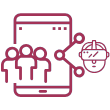VIRTUAL REALITY
VIRTUAL REALITY
After more than 10years of designing virtual training tools, we have developed a product adapted to your needs with which you can achieve real and measurable results that will optimize the operation of your company. Virtual training tools are very much in vogue and we have all heard of them. They appear at fairs and events and, for a while, immerse us, with greater or lesser success, in a virtual environment in which we can do things and in which we often have fun, but nevertheless, it is not always possible and it is certainly not an easy task to integrate these virtual training tools into the learning cycle of a school or training center.
At ANGRUP, we are dedicated to transforming teaching processes through virtual reality technologies and have spent years working on a new concept called ITC (Interactive Training Classroom), which goes far beyond a specific solution. ITC is not technology as such, it is a paradigm of use. It is the answer in the form of a solution that ANGRUPhas developed to be able to bring training through virtual reality systems to any training center in an economic and simple way, taking into account the particularities and requirements that are demanded in these types of centers.
At ANGRUP, we are dedicated to transforming teaching processes through virtual reality technologies and have spent years working on a new concept called ITC (Interactive Training Classroom), which goes far beyond a specific solution. ITC is not technology as such, it is a paradigm of use. It is the answer in the form of a solution that ANGRUPhas developed to be able to bring training through virtual reality systems to any training center in an economic and simple way, taking into account the particularities and requirements that are demanded in these types of centers.
The idea is to provide the training center with a system made up of an undetermined number of VR glasses (as many as students), and the instructor with a Tablet from which they can manage what happens in those glasses. Students identify themselves with their ID and access the virtual classroom. From de Tablet, the instructor launches a 3D animation, shows a 3D model, rotates it, enlarges it, points out certain areas, and can even disable parts of the model to be able to dive into the concept and thus be able to support the explanation he is giving. At the end of the explanation, he launches an exercise that allows evaluating, thanks to the “learning by doing” concept, to what extent the students have assimilated what the instructor wanted to teach them. The instructor, at all times, can see what each student is seeing, so they can solve questions face to face. At the end of each exercise, a report allows the instructor to evaluate each student in a personalized way.





